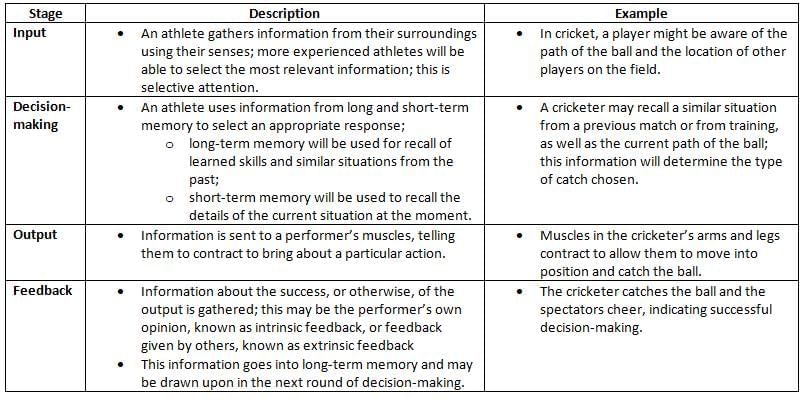Year 11 Exam > Year 11 Notes > Physical Education for GCSE/IGCSE > Basic Information Processing Model
Basic Information Processing Model | Physical Education for GCSE/IGCSE - Year 11 PDF Download
Processing Model
During a sports event, an athlete must make numerous decisions, including:
- Selecting the appropriate skill to use
- Determining the right moment to apply a specific skill
- Deciding how to execute the chosen skill, such as its speed, direction, and force
- The decisions an athlete makes depend on the particular circumstances of the situation.
- This process of decision-making is referred to as information processing, where an athlete collects information about the situation and then makes a suitable choice.
- The basic information processing model consists of the following stages:
- Input
- Decision-making
- Output
- Feedback
Basic information processing model table

The document Basic Information Processing Model | Physical Education for GCSE/IGCSE - Year 11 is a part of the Year 11 Course Physical Education for GCSE/IGCSE.
All you need of Year 11 at this link: Year 11
|
62 docs|5 tests
|
FAQs on Basic Information Processing Model - Physical Education for GCSE/IGCSE - Year 11
| 1. What is the Basic Information Processing Model and what are its key components? |  |
Ans. The Basic Information Processing Model is a framework used to understand how information is processed in various systems, including computers and human cognition. Its key components typically include the input stage, where data is received; the processing stage, where the data is manipulated or analyzed; and the output stage, where the processed information is delivered. Feedback mechanisms may also be included to refine the processing based on the output.
| 2. How does the Basic Information Processing Model apply to human cognition? |  |
Ans. In human cognition, the Basic Information Processing Model can be applied to understand how individuals perceive, interpret, and respond to information. The model illustrates how sensory input (input) is transformed into thoughts or decisions (processing) and then results in actions or verbal responses (output). This framework helps in studying attention, memory, and decision-making processes in psychology.
| 3. What are some examples of systems that utilize the Basic Information Processing Model? |  |
Ans. Several systems utilize the Basic Information Processing Model, including computer systems, artificial intelligence programs, and even biological systems such as the human brain. In computer systems, for instance, data is inputted through devices, processed by software, and outputted via displays or printers. Similarly, AI systems mimic cognitive functions by receiving data, processing it through algorithms, and providing results or actions based on that data.
| 4. What role does feedback play in the Basic Information Processing Model? |  |
Ans. Feedback plays a crucial role in the Basic Information Processing Model as it allows for adjustments and improvements in the processing stage. After the output is generated, feedback can inform the system about the effectiveness of the output, enabling the model to refine its processes. This iterative loop enhances performance and accuracy, whether in machines or human learning processes.
| 5. How can understanding the Basic Information Processing Model benefit students in their studies? |  |
Ans. Understanding the Basic Information Processing Model can benefit students by providing them with a clear framework for organizing information and improving learning strategies. By recognizing how they input information (through reading or listening), process it (through note-taking or summarizing), and output it (through discussions or exams), students can develop more effective study habits and enhance their overall academic performance.
Related Searches




















